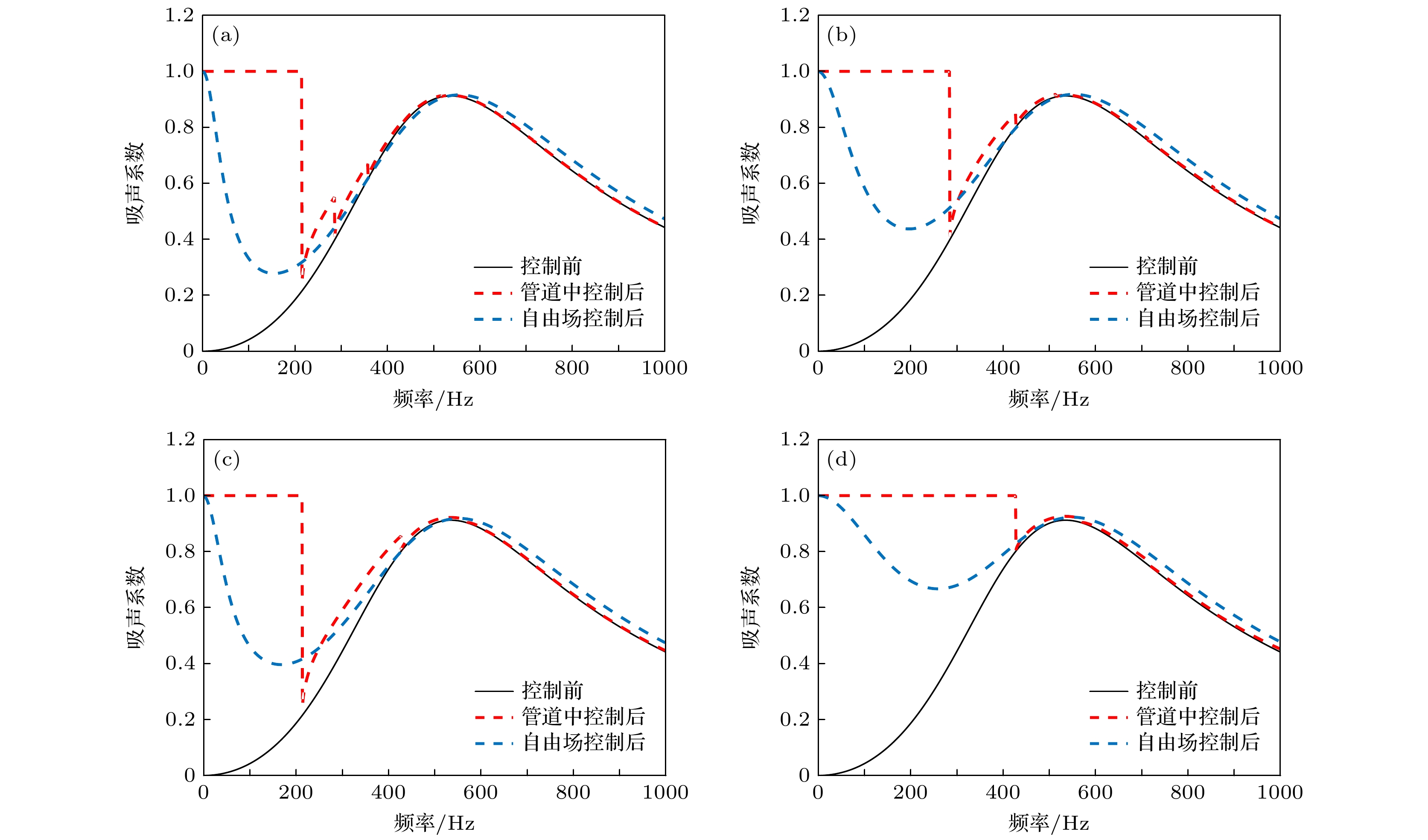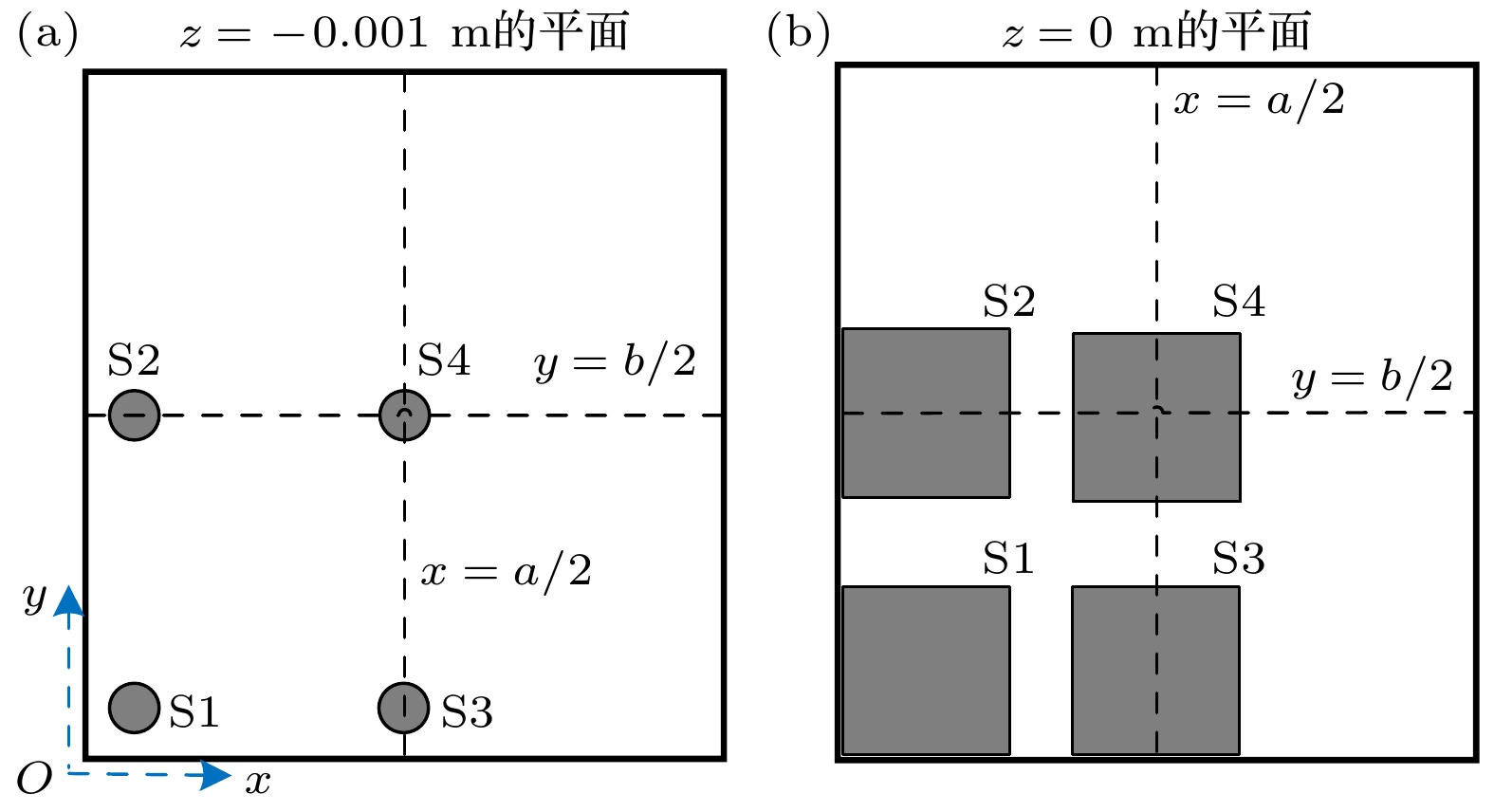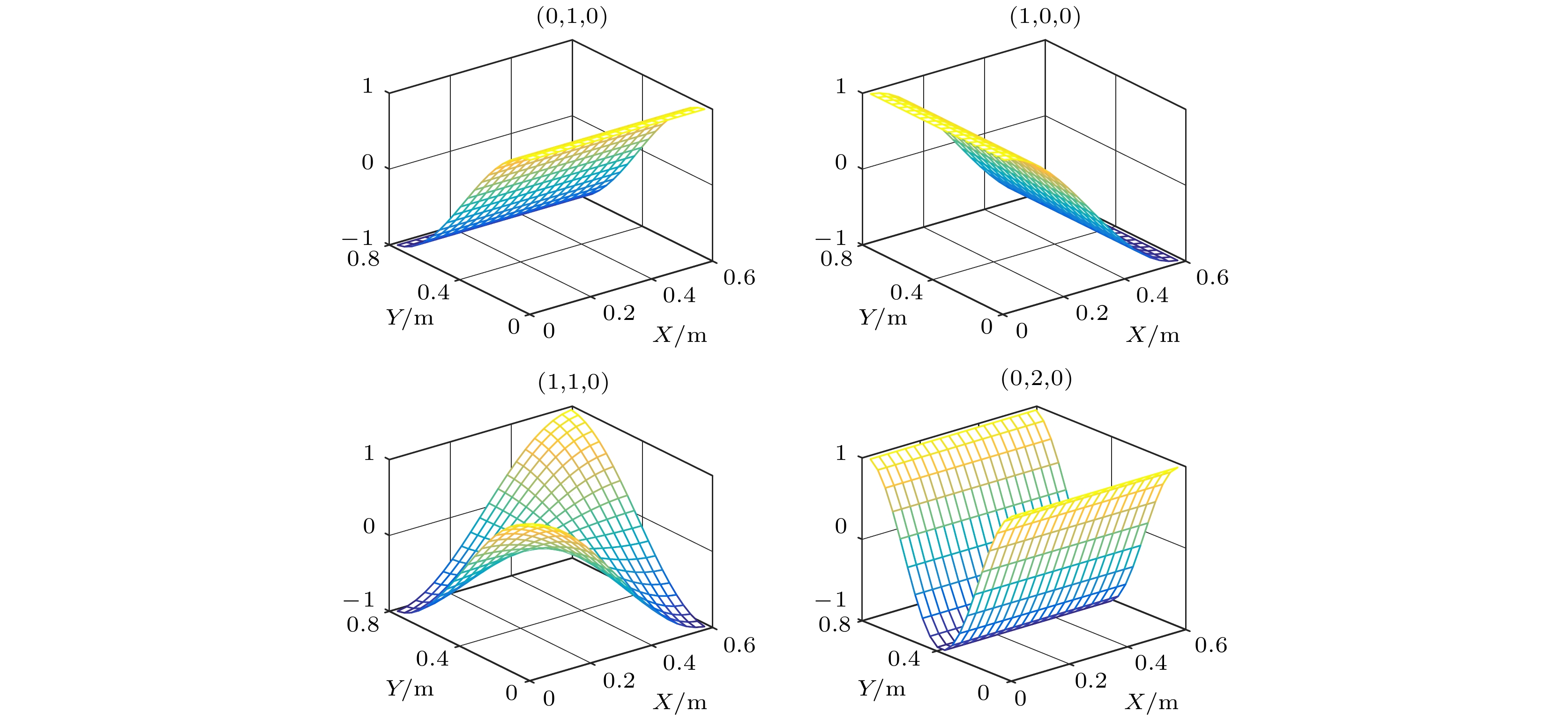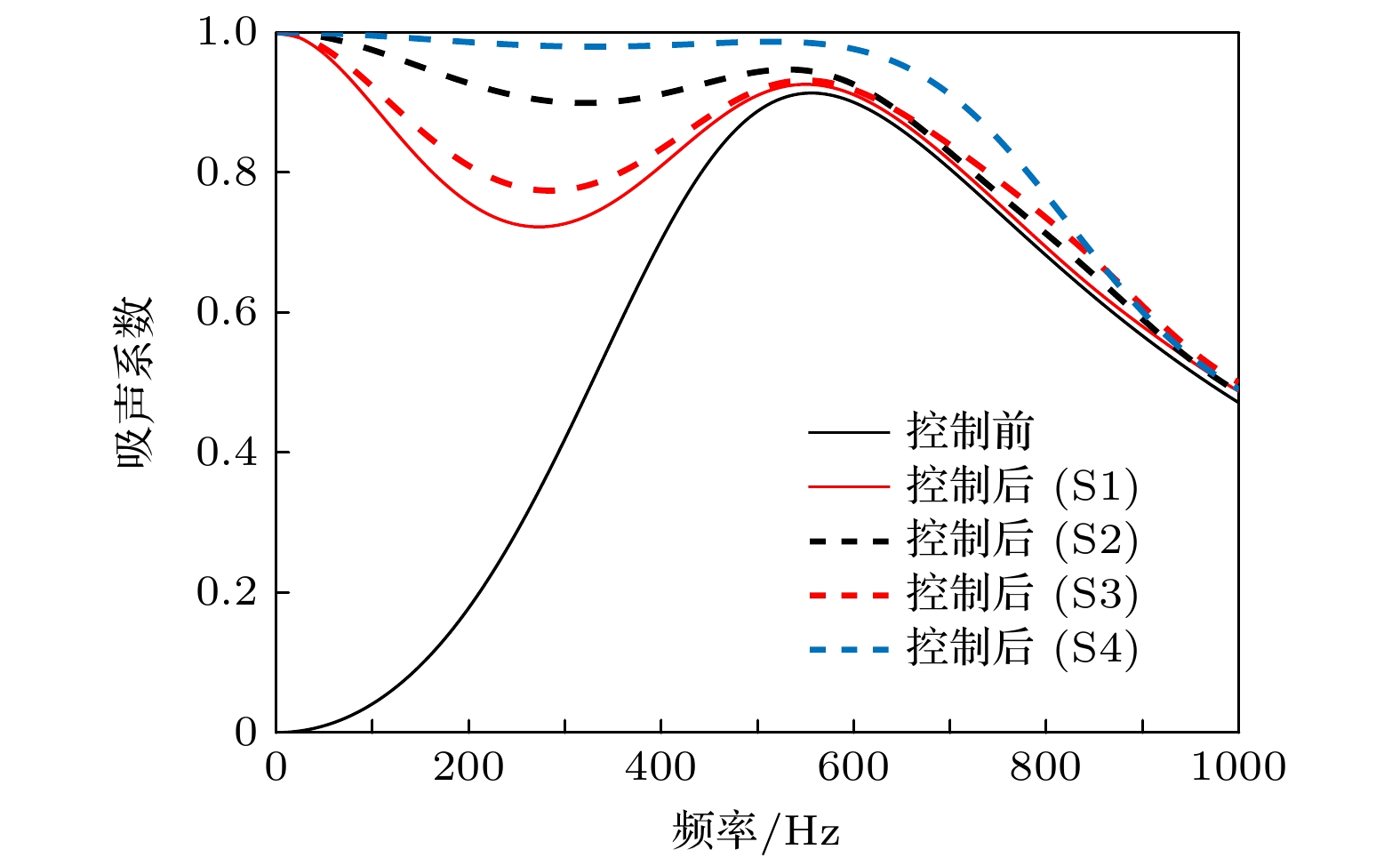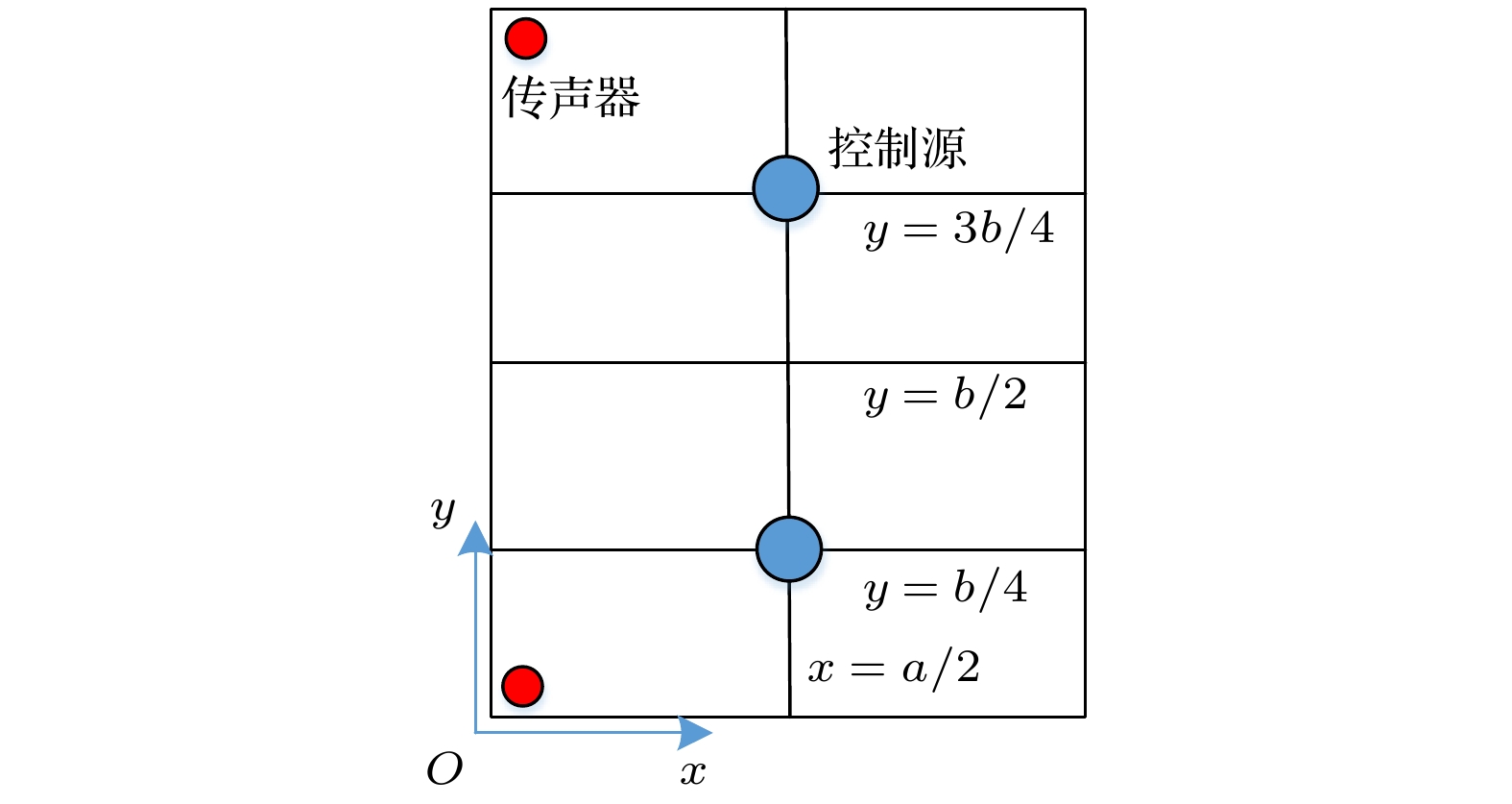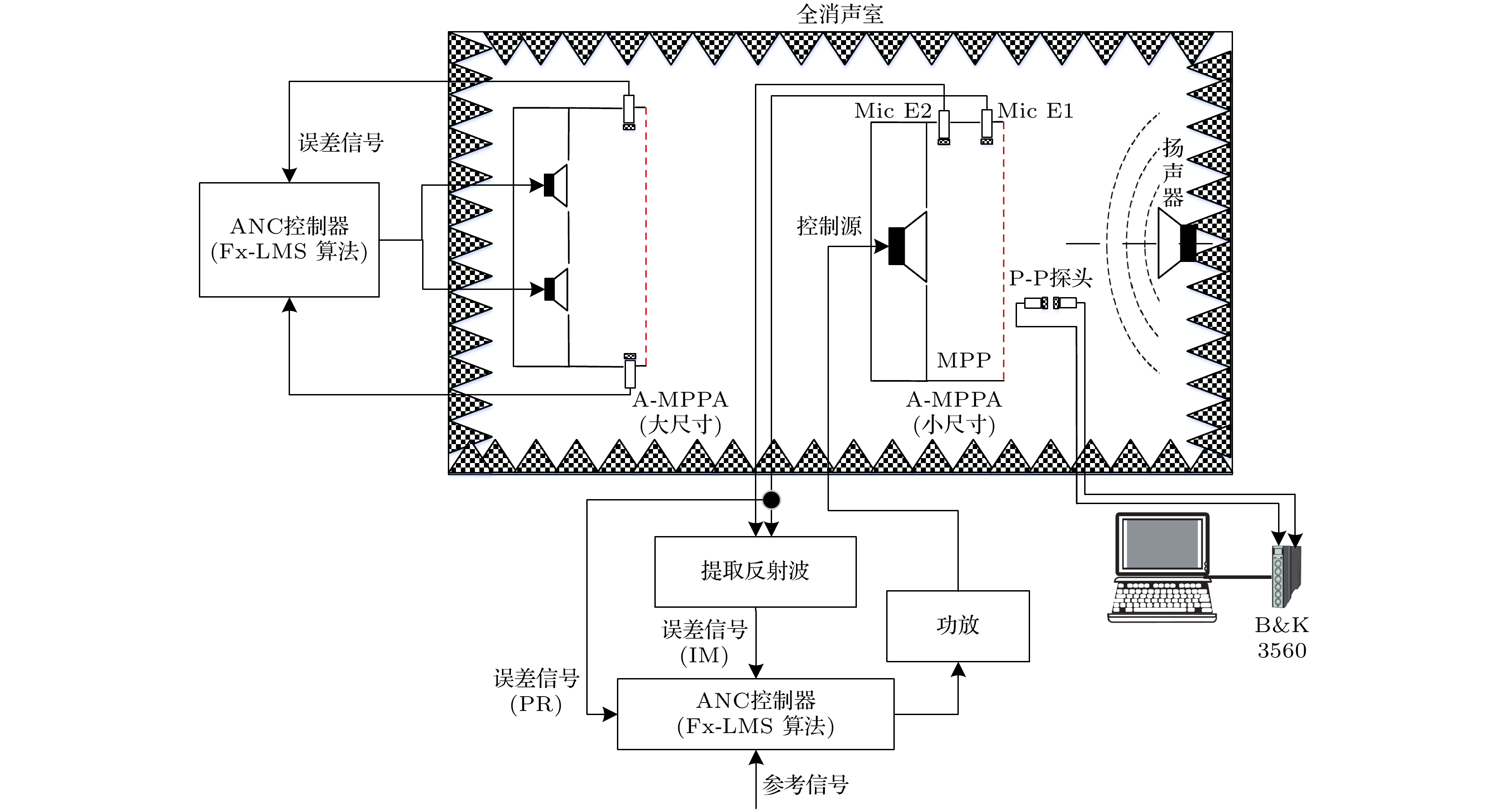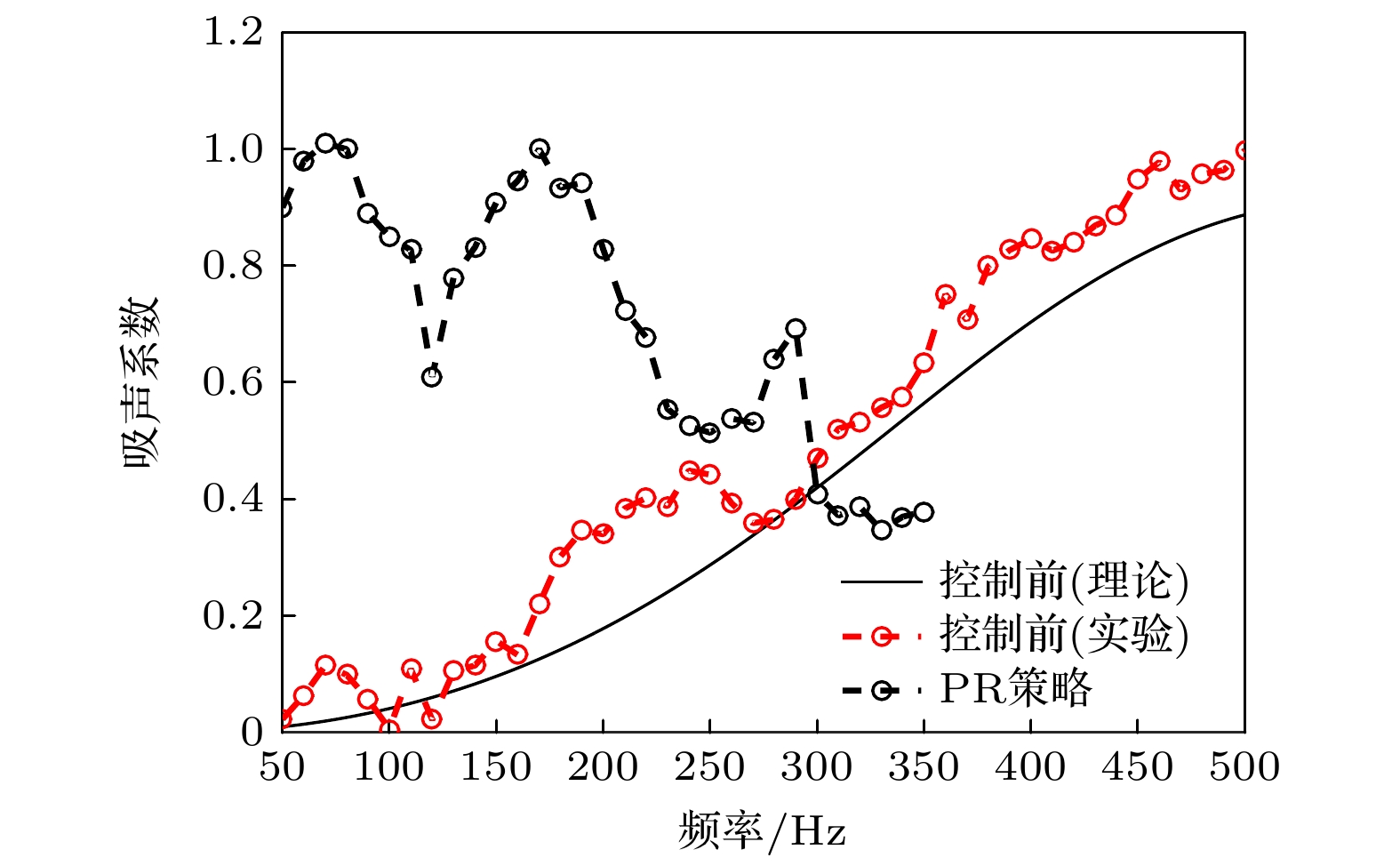-
大尺寸有源微穿孔板吸声器的低频吸声性能依赖于入射声场环境, 故在现有管道声场的研究基础上, 探究了其在自由场环境中的有源吸声性能. 首先, 引入随位置变化的声压反射系数表征非局部反应表面在垂直入射平面波激励下的反射声场, 并结合模态分析法建立理论模型. 其次, 从空腔声模态对入射波的反射作用及对声吸收的贡献度揭示了自由场中有源吸声的物理机制, 构建了误差传感策略. 最后, 实验验证了理论模型与所获结论的正确性. 研究表明: 入射波激励起的(0, 0, 0)空腔声模态, 其幅值越大对入射波的反射作用越强; 控制源抑制该声模态并使其幅值降到最优值时, 它不再反射并会大幅吸收入射波, 低频吸声性能显著提升. 但控制源激发的高阶空腔声模态对入射波起完全反射作用, 将阻碍控制性能的提升. 故相比于管道声场, 自由场中的有源吸声性能有所减弱. 控制源在抑制(0, 0, 0)声模态的同时能确保不大幅激起高阶声模态时, 声压释放和阻抗匹配传感策略对自由场环境仍然适用.The active micro-perforated panel absorber has excellent low frequency sound absorption performance, which is expected to realize low-frequency noise reduction in large space of the cabin. Since its active sound absorption performance depends on the incident sound field environment, on the basis of the existing research conclusions in the duct, the active sound absorption performance of the large-sized active micro-perforated panel absorber under the excitation of a normal incident plane wave in typical free field environment is in depth investigated. First, the theoretical model of the active micro-perforated panel absorber is established by using the modal analysis approach, in which a reflection coefficient varying with position is introduced to represent the reflected sound wave on the surface of the active micro-perforated panel absorber in free field. Then, the physical mechanism of active control is thoroughly analyzed and the error sensing strategy is established. Finally, an experiment is carried out to validate the theoretical model and findings. Results obtained demonstrate that the greater the amplitude of the (0, 0, 0) cavity mode excited by the incident plane wave, the stronger the reflection effect on the incident sound wave is, and vice versa. The control source suppresses the (0, 0, 0) mode so that this mode will not reflect and absorb the incident plane wave substantially when its amplitude is reduced to an optimal value. This is main mechanism of the sound absorption improvement in the low frequency range. However, the excited high order cavity modes (except for (0, 0, 0) mode) greatly reflect the incident sound energy in free field and exert a negative effect on sound absorption improvement. Thus, the control performance of the active micro-perforated panel absorber weakens in free field in comparison with that in the duct. The pressure-release and impedance-matching strategies are still applicable to free field as long as such a situation holds, i.e. the (0, 0, 0) cavity mode can be substantially suppressed by the control source and at the same time the high order cavity modes cannot be highly excited.
-
Keywords:
- micro-perforated panel absorber /
- low frequency active sound absorption /
- control mechanism in free sound field /
- error sensing strategy
[1] Maa D Y 1998 J. Acoust. Soc. Am. 104 2861
 Google Scholar
Google Scholar
[2] Zhang Z M, Gu X T 1998 J. Sound Vib. 215 399
 Google Scholar
Google Scholar
[3] Sakagami K, Nakamori T, Morimoto M, Yairi M 2009 Appl. Acoust. 70 703
 Google Scholar
Google Scholar
[4] Sakagami K, Matsutani K, Morimoto M 2010 Appl. Acoust. 71 411
 Google Scholar
Google Scholar
[5] Lee D H, Kwon Y P 2004 J. Sound Vib. 278 847
 Google Scholar
Google Scholar
[6] Ruiz H, Cobo P, Jacobsen F 2011 Appl. Acoust. 72 772
 Google Scholar
Google Scholar
[7] Tayong R B, Manyo J A, Siryabe E, Ntamack G E 2018 J. Acoust. Soc. Am. 143 2279
 Google Scholar
Google Scholar
[8] Wang C, Huang L 2011 J. Acoust. Soc. Am. 130 208
 Google Scholar
Google Scholar
[9] Wang C, Huang L, Zhang Y 2014 J. Sound Vib. 333 6828
 Google Scholar
Google Scholar
[10] Wang C Q, Cheng L, Pan J, Yu G H 2010 J. Acoust. Soc. Am. 127 238
 Google Scholar
Google Scholar
[11] Yang C, Cheng L, Pan J 2013 J. Acoust. Soc. Am. 133 201
 Google Scholar
Google Scholar
[12] Bravo T, Maury C 2018 J. Sound Vib. 425 189
 Google Scholar
Google Scholar
[13] Gai X, Li X, Zhang B, Xing T, Zhao J, Ma Z 2016 Appl. Acoust. 110 241
 Google Scholar
Google Scholar
[14] Gai X, Xing T, Li X, Zhang B 2018 Appl. Acoust. 137 98
 Google Scholar
Google Scholar
[15] Gai X, Xing T, Li X, Zhang B, Wang W 2016 Appl. Acoust. 114 260
 Google Scholar
Google Scholar
[16] Toyoda M, Takahashi D 2008 J. Acoust. Soc. Am. 124 3594
 Google Scholar
Google Scholar
[17] Liu J, Herrin D W 2010 Appl. Acoust. 71 120
 Google Scholar
Google Scholar
[18] Xie S, Wang D, Feng Z, Yang S 2020 Appl. Acoust. 158 1
 Google Scholar
Google Scholar
[19] Park S 2013 J. Sound Vib. 332 4895
 Google Scholar
Google Scholar
[20] Zhao X, Fan X 2015 Appl. Acoust. 88 123
 Google Scholar
Google Scholar
[21] Tao J, Jing R, Qiu X 2014 J. Acoust. Soc. Am. 135 231
 Google Scholar
Google Scholar
[22] Cobo P, Pfretzschner J, Cuesta M, Anthony D K 2004 J. Acoust. Soc. Am. 116 2118
 Google Scholar
Google Scholar
[23] Cobo P, Cuesta M 2007 J. Acoust. Soc. Am. 121 EL251
 Google Scholar
Google Scholar
[24] Cobo P, Cuesta M 2009 J. Acoust. Soc. Am. 125 185
 Google Scholar
Google Scholar
[25] Cobo P, Fernandez A, Doutres O 2003 J. Acoust. Soc. Am. 114 3211
 Google Scholar
Google Scholar
[26] Ma X Y, Chen K A, Wang L, Liu Y, Ding S 2022 Appl. Acoust. 185 108424
 Google Scholar
Google Scholar
[27] Ma X Y, Yurchenko D, Chen K A, Wang L, Liu Y, Yang K 2022 Mech. Syst. Signal Proc. 178 109295
 Google Scholar
Google Scholar
[28] Ma X Y, Chen K A, Wang L, Liu Y 2021 Shock Vib. 2021 6691505
 Google Scholar
Google Scholar
[29] 邹海山, 邱小军 2019 物理学报 68 054301
 Google Scholar
Google Scholar
Zou H S, Qiu X J 2019 Acta Phys. Sin. 68 054301
 Google Scholar
Google Scholar
[30] 吴飞, 黄威, 陈文渊, 肖勇, 郁殿龙, 温激鸿 2020 物理学报 69 134303
 Google Scholar
Google Scholar
Wu F, Huang W, Chen W Y, Xiao Y, Yu D L, Wen J H 2020 Acta Phys. Sin. 69 134303
 Google Scholar
Google Scholar
[31] 张丰辉, 唐宇帆, 辛锋先, 卢天健 2018 物理学报 67 234302
 Google Scholar
Google Scholar
Zhang F H, Tang Y F, Xin F X, Lu T J 2018 Acta Phys. Sin. 67 234302
 Google Scholar
Google Scholar
[32] Lee Y Y, Lee E W M, Ng C F 2005 J. Sound Vib. 287 227
 Google Scholar
Google Scholar
[33] Bravo T, Maury C, Pinhede C 2012 J. Acoust. Soc. Am. 132 789
 Google Scholar
Google Scholar
[34] 马玺越, 陈克安, 丁少虎, 张冰瑞 2013 物理学报 62 124301
 Google Scholar
Google Scholar
Ma X Y, Chen K A, Ding S H, Zhang B R 2013 Acta Phys. Sin. 62 124301
 Google Scholar
Google Scholar
[35] Bravo T, Maury C, Pinhede C 2012 J. Acoust. Soc. Am. 131 3853
 Google Scholar
Google Scholar
-
图 6 点源分别位于S1和S4时控制前后的归一化声功率
$ {\tilde \varPi _1} $ ,$ {\tilde \varPi _{\text{2}}} $ ,$ {\tilde \varPi _3} $ 与$ 1 - ({\tilde \varPi _1} + {\tilde \varPi _2} + {\tilde \varPi _3}) $ (a) 控制前; (b) 点源位于S4时控制后; (c) 与(d)点源位于S1时控制后Fig. 6. Normalized sound power
$ {\tilde \varPi _1} $ ,$ {\tilde \varPi _1} $ ,$ {\tilde \varPi _3} $ , and$ 1 - ({\tilde \varPi _1} + {\tilde \varPi _2} + {\tilde \varPi _3}) $ with and without control when the point source locates at S1 and S4: (a) Without control; (b) with control when the point source locates at S4; (c) and (d) with control when the point source locates at S1.表 1 模型的几何参数
Table 1. Geometric parameters of the model.
参数 数值 A-MPPA尺寸(长×宽) 0.3 m×0.4 m (活塞源)0.6 m×0.8 m (点声源) MPP的孔隙直径/m $ 0.4 \times {10^{ - 3}} $ MPP的厚度/m $ 0.5 \times {10^{ - 3}} $ MPP的孔隙率/% 1 A-MPPA的空腔深度/m 0.08 空气的黏度系数/(Pa·s) 1.882×10–5 表 2 点源与活塞源的位置
Table 2. Position of the point source and the piston source.
位置 坐标/m 点源
(0.6 m×0.8 m)活塞源的中心位置
(0.3 m×0.4 m)S1 (0.01, 0.01, –0.001) (0.05, 0.05, 0) S2 (0.01, 0.4, –0.001) (0.05, 0.2, 0) S3 (0.3, 0.01, –0.001) (0.15, 0.05, 0) S4 (0.3, 0.4, –0.001) (0.15, 0.2, 0) 表 3 两种尺寸下A-MPPA中空腔前五阶声模态的共振频率
Table 3. Resonant frequencies of the first five cavity modes for these two cases of A-MPPA size.
序号 空腔声模态 共振频率/Hz 0.6 m×0.8 m 0.3 m×0.4 m 1 (0, 0, 0) 0 0 2 (0, 1, 0) 215 430 3 (1, 0, 0) 287 574 4 (1, 1, 0) 358 716 5 (0, 2, 0) 430 860 -
[1] Maa D Y 1998 J. Acoust. Soc. Am. 104 2861
 Google Scholar
Google Scholar
[2] Zhang Z M, Gu X T 1998 J. Sound Vib. 215 399
 Google Scholar
Google Scholar
[3] Sakagami K, Nakamori T, Morimoto M, Yairi M 2009 Appl. Acoust. 70 703
 Google Scholar
Google Scholar
[4] Sakagami K, Matsutani K, Morimoto M 2010 Appl. Acoust. 71 411
 Google Scholar
Google Scholar
[5] Lee D H, Kwon Y P 2004 J. Sound Vib. 278 847
 Google Scholar
Google Scholar
[6] Ruiz H, Cobo P, Jacobsen F 2011 Appl. Acoust. 72 772
 Google Scholar
Google Scholar
[7] Tayong R B, Manyo J A, Siryabe E, Ntamack G E 2018 J. Acoust. Soc. Am. 143 2279
 Google Scholar
Google Scholar
[8] Wang C, Huang L 2011 J. Acoust. Soc. Am. 130 208
 Google Scholar
Google Scholar
[9] Wang C, Huang L, Zhang Y 2014 J. Sound Vib. 333 6828
 Google Scholar
Google Scholar
[10] Wang C Q, Cheng L, Pan J, Yu G H 2010 J. Acoust. Soc. Am. 127 238
 Google Scholar
Google Scholar
[11] Yang C, Cheng L, Pan J 2013 J. Acoust. Soc. Am. 133 201
 Google Scholar
Google Scholar
[12] Bravo T, Maury C 2018 J. Sound Vib. 425 189
 Google Scholar
Google Scholar
[13] Gai X, Li X, Zhang B, Xing T, Zhao J, Ma Z 2016 Appl. Acoust. 110 241
 Google Scholar
Google Scholar
[14] Gai X, Xing T, Li X, Zhang B 2018 Appl. Acoust. 137 98
 Google Scholar
Google Scholar
[15] Gai X, Xing T, Li X, Zhang B, Wang W 2016 Appl. Acoust. 114 260
 Google Scholar
Google Scholar
[16] Toyoda M, Takahashi D 2008 J. Acoust. Soc. Am. 124 3594
 Google Scholar
Google Scholar
[17] Liu J, Herrin D W 2010 Appl. Acoust. 71 120
 Google Scholar
Google Scholar
[18] Xie S, Wang D, Feng Z, Yang S 2020 Appl. Acoust. 158 1
 Google Scholar
Google Scholar
[19] Park S 2013 J. Sound Vib. 332 4895
 Google Scholar
Google Scholar
[20] Zhao X, Fan X 2015 Appl. Acoust. 88 123
 Google Scholar
Google Scholar
[21] Tao J, Jing R, Qiu X 2014 J. Acoust. Soc. Am. 135 231
 Google Scholar
Google Scholar
[22] Cobo P, Pfretzschner J, Cuesta M, Anthony D K 2004 J. Acoust. Soc. Am. 116 2118
 Google Scholar
Google Scholar
[23] Cobo P, Cuesta M 2007 J. Acoust. Soc. Am. 121 EL251
 Google Scholar
Google Scholar
[24] Cobo P, Cuesta M 2009 J. Acoust. Soc. Am. 125 185
 Google Scholar
Google Scholar
[25] Cobo P, Fernandez A, Doutres O 2003 J. Acoust. Soc. Am. 114 3211
 Google Scholar
Google Scholar
[26] Ma X Y, Chen K A, Wang L, Liu Y, Ding S 2022 Appl. Acoust. 185 108424
 Google Scholar
Google Scholar
[27] Ma X Y, Yurchenko D, Chen K A, Wang L, Liu Y, Yang K 2022 Mech. Syst. Signal Proc. 178 109295
 Google Scholar
Google Scholar
[28] Ma X Y, Chen K A, Wang L, Liu Y 2021 Shock Vib. 2021 6691505
 Google Scholar
Google Scholar
[29] 邹海山, 邱小军 2019 物理学报 68 054301
 Google Scholar
Google Scholar
Zou H S, Qiu X J 2019 Acta Phys. Sin. 68 054301
 Google Scholar
Google Scholar
[30] 吴飞, 黄威, 陈文渊, 肖勇, 郁殿龙, 温激鸿 2020 物理学报 69 134303
 Google Scholar
Google Scholar
Wu F, Huang W, Chen W Y, Xiao Y, Yu D L, Wen J H 2020 Acta Phys. Sin. 69 134303
 Google Scholar
Google Scholar
[31] 张丰辉, 唐宇帆, 辛锋先, 卢天健 2018 物理学报 67 234302
 Google Scholar
Google Scholar
Zhang F H, Tang Y F, Xin F X, Lu T J 2018 Acta Phys. Sin. 67 234302
 Google Scholar
Google Scholar
[32] Lee Y Y, Lee E W M, Ng C F 2005 J. Sound Vib. 287 227
 Google Scholar
Google Scholar
[33] Bravo T, Maury C, Pinhede C 2012 J. Acoust. Soc. Am. 132 789
 Google Scholar
Google Scholar
[34] 马玺越, 陈克安, 丁少虎, 张冰瑞 2013 物理学报 62 124301
 Google Scholar
Google Scholar
Ma X Y, Chen K A, Ding S H, Zhang B R 2013 Acta Phys. Sin. 62 124301
 Google Scholar
Google Scholar
[35] Bravo T, Maury C, Pinhede C 2012 J. Acoust. Soc. Am. 131 3853
 Google Scholar
Google Scholar
计量
- 文章访问数: 6070
- PDF下载量: 98
- 被引次数: 0













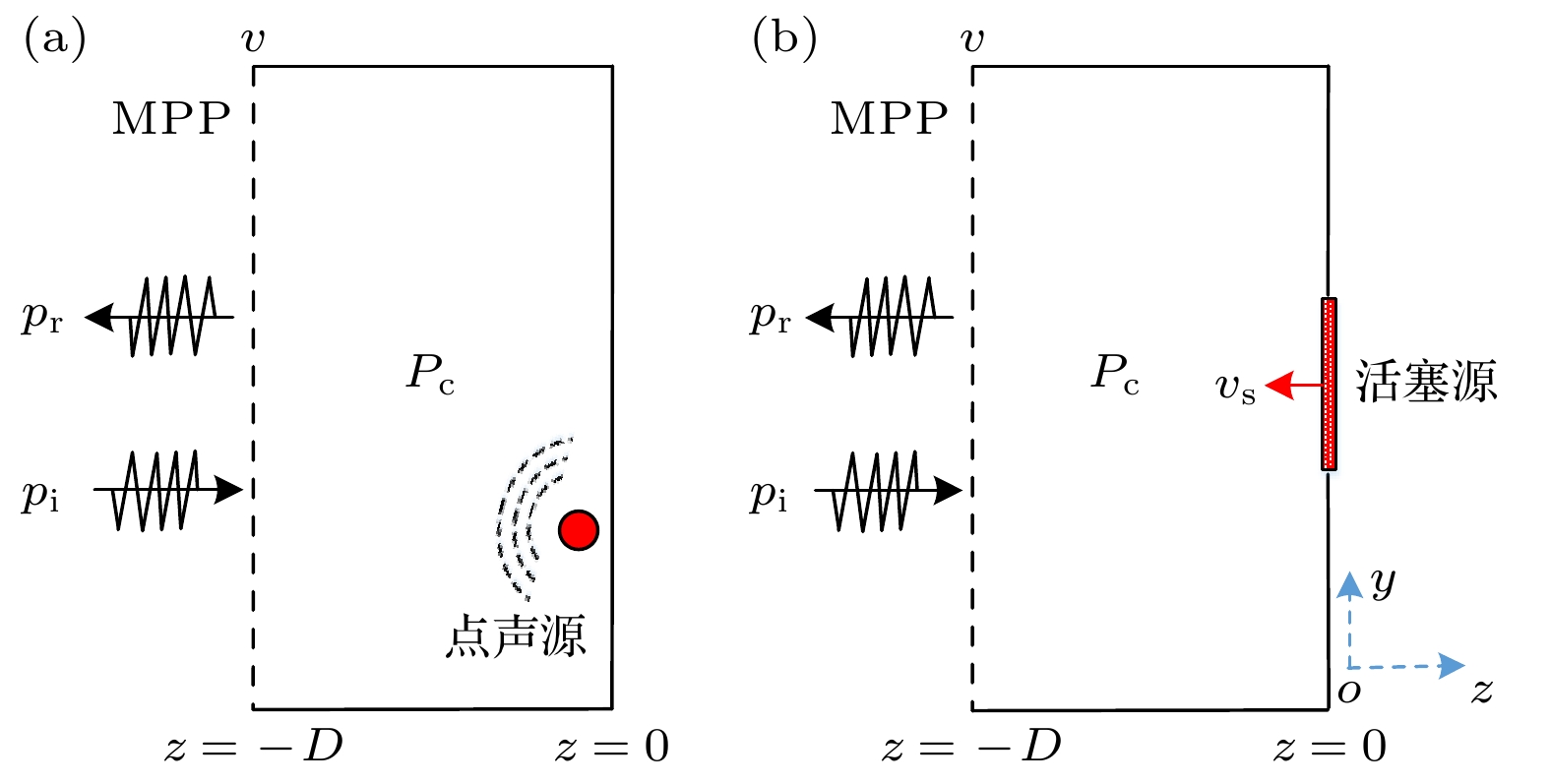
 下载:
下载:

